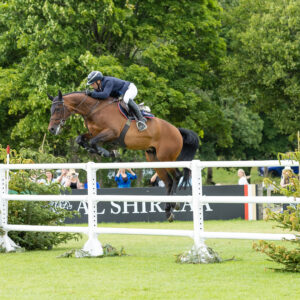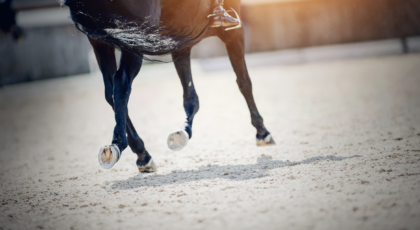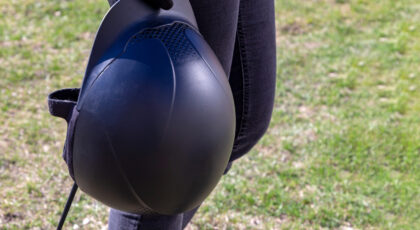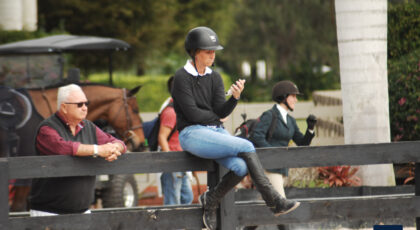In his most famous poem cycle, T.S. Eliot writes: “The naming of cats is a difficult matter…”
So, too, with the naming of a Thoroughbred foal who someday may carry that name to racetracks around the world and into legend forever.
A name like Man o’ War seems most appropriate for one of the all-time greats, as does Upset, the name of the only horse to ever beat the Champion in the 1919 Sanford Stakes at Saratoga. Secretariat got his name by accident when five names submitted to The Jockey Club by Meadow Stables for owner Penny Chenery were rejected for various reasons and the sixth, winning submission came from Elizabeth Ham—the secretary at Meadow Stables. The name of this year’s two-year-old undefeated Eclipse Award winner, Game Winner, seems right on target and the name Justify seems to foretell the controversy that would surround justifying the undefeated, but lightly raced, colt’s Eclipse Award as Horse of the Year.
Myth and folklore serve as rich sources for Thoroughbred naming and perhaps no horse better bore witness to his name than the one named after an African American folk hero, “a big, powerful man” immortalized in story, statue and song, a man who supposedly bettered a pile-driving steam drill (being tested for use by the Chesapeake & Ohio Railroad) in a two-day-long contest in 1872. As the poem goes: “John Henry was a steel-drivin’ man, who died with a hammer in his hand,” it is claimed during the contest from the strain on his heart.

The Great Bend railway tunnel in Talcott West Virginia is supposedly the site of the legendary contest between John Henry and a steam powered drill. ©EJ Keats Foundation
John Henry the man was debatably real, but there is no doubt that the late John Henry the horse was very much so, despite his unreal accomplishments.
Sometimes referred to as “The People’s Champion,” John Henry was foaled in Kentucky at Golden Chance Farms March 9, 1975 by a sire with the equally workhorse-sounding name of Old Bob Bowers and the otherwise undistinguished dam, Once Double. The usual suspects like Northern Dancer are nowhere to be found in his pedigree.
Plain brown and undersized, he was born with a knee malformation that mistakenly predicted a brief racing career. He had an early habit of tearing his steel grain buckets from his stall wall and stomping them flat, a temperament issue that, along with his ordinary breeding, led to his name and subsequent gelding.
John Henry’s early racing career showed some promise.
He won the Lafayette Futurity at two and the Grade 3 Round Table Handicap at three. But his lack of size, overbearing temperament even after gelding and poor conformation resulted in a series of owners and an underpriced sales record. He sold for only $1,100 as a yearling, later for $2,200 as a two-year-old. A veterinarian voided a subsequent $7,500 sale because of his malformed knee.
Ordinary Manhattan businessman Sam Rubin, not a horseman but a bicycle importer and salesman with a gambler’s eye and temperament, still came along with a whopping $25,000 to take a flyer on him.
Until then, John Henry had been living the life of a poorly bred, ill-tempered gelding without future breeding possibilities for his previous owners. He ran erratically in low-stakes dirt races in Louisiana and the $50,000 he had earned in nearly three years seemed his peak earning potential.
New owner Rubin decided to move his new acquisition to his home state of New York to run at Belmont Park and perhaps recoup his investment at a decent profit. So it was that on June 1, 1978, trainer Bobby Donato chose to try John Henry on grass for the first time in his 19th start, a $35,000 claimer race.
John Henry won the turf race by 12 lengths. Unclaimed, that would be the last time he’d be offered for sale.
Lost in Thoroughbred history is the never-to-be-realized on-track relationship between John Henry and another horse foaled 15 days earlier on February 21 of the same year—one better bred but also thought at first to be more average than extraordinary. Just nine days after the Belmont run that quietly changed racing history, another pivotal moment would be made far more loudly when Affirmed successfully battled Alydar through the Belmont backstretch to become the 11th winner of the Triple Crown, the last horse to earn that honor for the next 37 years until American Pharoah accomplished the feat in 2015.

Born only 15 days apart in 1975, Triple Crown winner Affirmed and The People’s Champion John Henry never faced each other on the racetrack. ©NYDaily News Archives
Both horses would compete at Saratoga that summer, but never face each other.
Affirmed was strictly a dirt horse and John Henry’s future to earn the green seemed to be on the green. Still, for some unknown reason, Donato returned John Henry to dirt that summer, not against Affirmed, but in an August allowance race where he would be trounced by a field that included Darby Creek Road, 13 lengths a loser behind Affirmed in the Kentucky Derby, third in the Preakness.
Thirty minutes later, Affirmed won the Jim Dandy Stakes.
John Henry’s seeming slide into obscurity versus the Triple Crown winner continued. Back on turf 10 days later, he finished an uninspiring fourth. The next day Affirmed, with Laffit Pincay riding in place of the injured Steve Cauthen, would again best Alydar by 1 3/4 lengths in the Travers, but see his win reversed by stewards in perhaps the most bitter disqualification in Saratoga history.
John Henry and Affirmed both went in their literal opposite directions.
Affirmed went West to Santa Anita where, with Cauthen back up, he suffered a third-place finish in the Malibu Stakes and was runner up in the San Fernando, behind undistinguished winners in both races. Cauthen, then saddled with a losing streak that had reached 110 races, was replaced by Pincay. Affirmed went on to win his final seven races.
Triple Crown winner Affirmed was retired to stud following his four-year-old campaign, earning a total of $2.4 million and racing immortality while John Henry trudged East to continue his racing career. He was, after all, a gelding with no monetary value off the racetrack.
Horse lovers and even some horsemen and women are conflicted about geldings.
On the one hand, they may embrace the idea of racehorses gracing the racetrack to the delight of fans beyond three years and especially, as in the case of Justify, after a mere six races. On the other, horses raced because they have no breeding potential are often seen—and perhaps sometimes are—abused, running far beyond what soundness and sound judgement suggest are desirable.
But John Henry, perhaps exceptional in no other way, was the exception that questions this rule. His greatest glory lay before him, through many races over many more years.
Trainer Donato was replaced by Lefty Nickerson at the beginning of John Henry’s four-year-old campaign. Under Donato, he had won six of 19 starts and bankrolled over $120,000. He enjoyed some initial success under Nickerson, winning four of his 11 races.
Again seeking to find the right mix of track and trainer, Rubin decided to move John Henry to California in the care of Nickerson’s friend, John McAnally, who would remain his primary trainer during his California career and saddled John Henry to his most significant wins, beginning with six consecutive stakes victories. Nickerson continued to handle East Coast duties as John Henry competed at tracks across the U.S. over a racing career that lasted nearly a decade.
John Henry gave hints of his true greatness beginning as a five-year-old in 1980. He won eight graded stakes races that year including four G1s, among them the first of two consecutive of three Hollywood Invitational Turf Handicap wins, and was runner up in both the G3 Sword Dancer on turf at Saratoga and the G1 Jockey Club Gold Cup on dirt at Belmont, two races he would win the following year.
John Henry would enjoy his best statistical year in 1981 at six.
He won the first of his two consecutive Santa Anita “Big Cap” Handicaps that year under Pincay, the following year under Bill Shoemaker, one of only four horses (with Game On Dude, 2013–14; Lava Man, 2006–07; Milwaukee Brew, 2002–03) to achieve consecutive wins in the race’s 80 runnings. He won the inaugural Arlington Million by a nose over The Bart. John Henry snared the second of his three wins in the Hollywood Turf, then added the Sword Dancer and the Jockey Club Gold for good measure. He was named Horse of the Year by a unanimous vote, the only horse to earn an unblemished HOY vote until American Pharoah in 2015.
John Henry would add four graded stakes wins to his record over the next two years, including a repeat in the Santa Anita when Perrault was disqualified from the win, but he seemed to have passed his peak. Then came 1984 and his final year on the track as a nine-year-old. Chris McCarron had assumed duties as his regular rider and would keep the mount through his final 14 starts, the last of John Henry’s career riders.
In a year perhaps more amazing than 1981, McNally saddled “the old man” to wins in six stakes races, three G1s among them, including the Arlington Million, rebranded temporarily as the Budweiser Million, and a third Hollywood Invitational Turf. Perhaps his greatest feat that year was to be named Horse of the Year a second time, at nine the oldest horse to ever earn that honor.
John Henry was a late entry in that year’s inaugural Breeders’ Cup Classic but was withdrawn after discovery of a strained left foreleg ligament. He never raced again. Injury finally achieved the retirement that eluded both time and younger competition.
Owner Rubin was besieged with retirement requests from several California racetracks, the state where John Henry achieved his racing greatness, but settled on the Hall of Champions at The Kentucky Horse Park back in the Champion’s home state of Kentucky. He was the first of several significant racehorses to be retired there, including Cigar, perhaps the only other racehorse to achieve a comparable racetrack resume.

Even other horses at Kentucky Horse Park would stare in awe of a 30-year-old retired John Henry. ©Steve Faust/Kentucky Horse Park
As tough in retirement as he was gritty on the track, John Henry delighted visitors for over two decades until Father Time finally had its way with the unbreakable Champion. Non-responsive to veterinary treatment for chronic kidney failure, the decision was made to euthanize John Henry the morning of Oct. 8, 2007 at age 32. He was laid to rest that evening at a site in front of his private paddock.
A bronze statue of the Champion is a centerpiece enshrined at Santa Anita Park, the site of John Henry’s most memorable success.

A bronze statue of John Henry Bronze at California’s Santa Anita Park, the site of some of his greatest triumphs. ©Richard R Gross
On the occasion of his passing, jockey McCarron said “…the most impressive and captivating thing about him is that he maintained his incredible form right up until the time he was retired. Other horses have raced at that age, but not at that level.”
That level saw John Henry race 83 times under 17 different jockeys, 12 of them over his first 39 races. He ran in 46 graded stakes races over 18 different tracks, winning 25 of those races. He would enjoy his greatest successes saddled by McAnally and ridden by Darrel McHargue, Angel Cordero Jr., Laffit Pincay, Bill Shoemaker and McCarron, who rode him 11, 2, 7, 10 and 14 times respectively. Owner Rubin’s $25,000 gamble paid off to the tune of $6,591,860, all but $50,000 of it under his ownership.
“He’d win on grass, dirt, West Coast, East Coast,” declared Cordero. “He’d win on the lead, come from behind. He could handle anything. He ran until he was old, fought every good horse that was around then. He’s on my list of the best of all time.”
In addition to his two Horse of the Year Eclipse Awards, John Henry won the Eclipse Award as Champion Turf Horse in 1980, 1981, 1983 and 1984, and as Champion Older Male in 1981. He was inducted into the National Museum of Racing and Hall of Fame in Saratoga in 1990 and is perhaps a too-low #23 in The Blood-Horse ranking of the top 100 Thoroughbred Champions of the 20th Century.
As a racehorse, John Henry was to the Thoroughbred breed what Northern Dancer was genetically as a stallion.
“He would double the size of any crowd wherever we went,” recalled McCarron. “There was just so much excitement surrounding him. To have shared that with him 14 times was just awesome.”
At a time when the economics of breeding dictate that a racehorse be retired to a lucrative stallion career after only a significant win or two, or that the occasional dangerous competitor be avoided on the racetrack, there will never be another horse like John Henry: the undersized, ornery, steel-bucket-stomping colt in the plain brown wrapper who became The People’s Champion.

John Henry was laid to rest outside his paddock at The Kentucky Horse Park on the day he passed in 2007. ©Steve Faust/Kentucky Horse Park


 February 7, 2019
February 7, 2019 

























